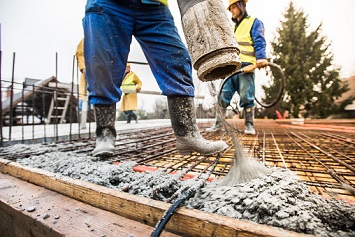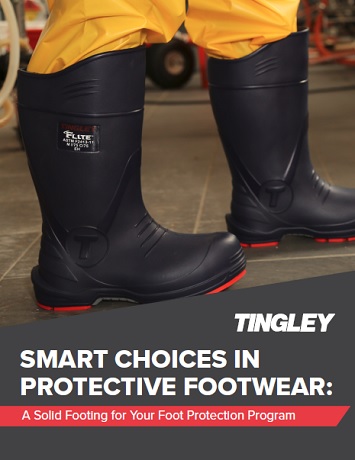Many employers have questions about what specific footwear would best fit their foot protection programs. Experts at Safety.BLR.com® recently stepped in to answer two questions on the subject—see what they had to say, plus download a free guide from Tingley to get your program on firm ground!

simonkr / E+ / Getty Images
Question: How do aluminum safety toe boots compare to steel and composite toe boots? Our company only allows steel and composite, but I thought all safety boots meet the same ANSI standard.
Answer: As you stated, there are three types of protective toes: steel, composite, and aluminum/alloy. All safety toe footwear must pass the same impact and compression tests to be rated compliant with American Society for Testing and Materials (ASTM) standards, but the different types do have distinguishing characteristics.
Steel toe boots provide maximum protection and are less expensive than alloy or composite toe boots.
Aluminum/alloy toe safety boots are lighter, but generally less protective against impacts from falling objects, compression, and shearing than steel toe boots. They are also more expensive.
Composite toe boots are not as strong as steel or alloy toe boots, so they must be thicker and more bulbous to achieve the same safety ratings, and the composite material can weaken over time. They are also less protective against dropped objects and shearing than steel or alloy. However, composite toe boots are lighter than steel toe boots, and they have the added benefit of better insulation against hot and cold temperatures.
You should note that though OSHA allows employers to use PPE constructed in accordance with any of three national consensus standards (ASTM F-2412-2005, “Standard Test Methods for Foot Protection,” and ASTM F-2413-2005, “Standard Specification for Performance Requirements for Protective Footwear”; ANSI Z41-1999, “American National Standard for Personal Protection–Protective Footwear”; or ANSI Z41-1991, “American National Standard for Personal Protection–Protective Footwear”), ANSI Z41 was withdrawn and replaced by standards ASTM F2412 and ASTM F2413 in 2005. As a result, manufacturers no longer follow ANSI Z41, but instead follow the ASTM standards for steel, aluminum/alloy, and composite toe boots.
Further detail of the standards and their comparisons of the types of safety toes may be obtained by contacting www.astm.org.
Question: As a car wash business, should we be requiring employees to wear static dissipative shoes? There was a question of whether we (the employer) must pay for safety shoes for our employees. My answer has always been no, that shoes are for the most part exempt from that standard, but I want to be sure that we shouldn’t be requiring specialty shoes. How do you determine whether you need static dissipative shoes at a worksite? We are a car wash business, and we occasionally handle containers of flammable liquids (wash product and gas cans for lawnmowers, leaf blowers, etc.). But I don’t know the threshold for requiring specialty shoes.
Answer: You are correct that employer payment for standard safety shoes is not required as long as employees are allowed to wear the shoes off the jobsite and the shoes are not specialty shoes (29 CFR 1910.132(h)(2)).
As to your question regarding whether you should be providing static dissipative shoes, which would qualify as specialty shoes (and thus would need to be paid for by the employer), it is up to each employer to perform a hazard assessment of the work environment and make a determination as to the personal protective equipment (PPE), including foot protection, that provides the needed level of protection from the hazards employees are exposed to on the job.
At 29 CFR 1910.136(a), OSHA requires the use of protective footwear when it will protect employees from an electrical hazard, such as a static-discharge or electric-shock hazard.
Although we cannot make a definitive determination without knowing more details about your worksite, it seems unlikely that static dissipative shoes would be necessary. Static dissipative shoes are typically worn by workers in electronics assembly and other industries where static electricity can damage sensitive parts. A car wash environment does not seem to be a situation that would necessitate the use of these shoes.
Depending on the nature of the flammable liquids your workers handle and the other hazards present in your workplace, it is possible that electrically conductive shoes would be more appropriate than static-dissipative footwear. Conductive footwear is worn in environments where explosives are handled or where highly flammable atmospheres are common, thus making static electric sparks very dangerous. However, again, this depends on your operations, and it is possible that conductive footwear is not necessary or appropriate for your employees. In addition, employees exposed to electrical hazards must never wear conductive shoes, so that is an additional consideration to take into account in your hazard assessment, as the use of PPE must not create additional hazards.
The ASTM F2412 and F2413 standards set out testing and performance requirements for protective footwear. OSHA references these standards in its foot protection standard at 29 CFR 1910.136(b)(1)(i), and you may wish to review these standards for additional information to help you determine the type of foot protection that is most appropriate for your employees.
Want to learn more about protective footwear? Download Tingley’s free guide, Smart Choices in Protective Footwear: A Solid Footing for Your Foot Protection Program today!

